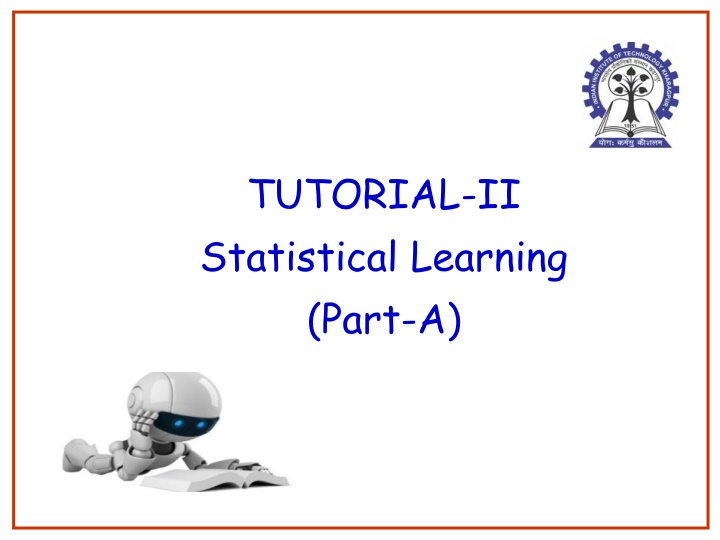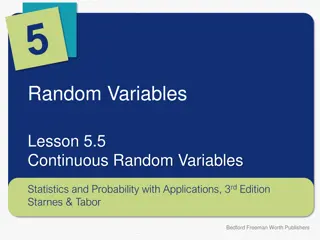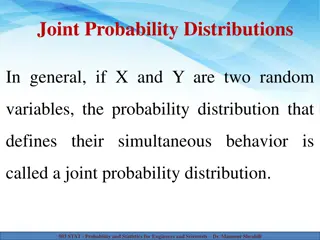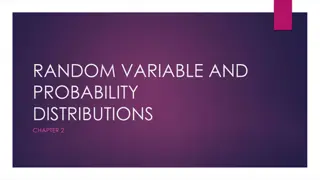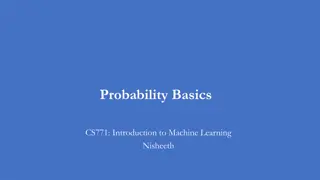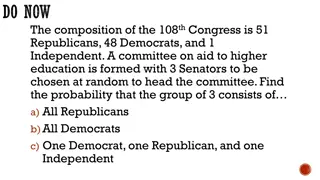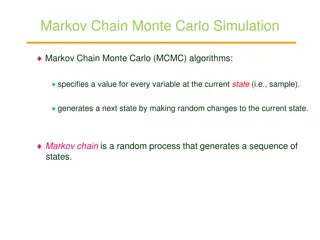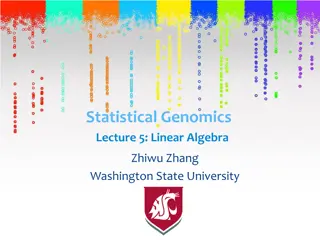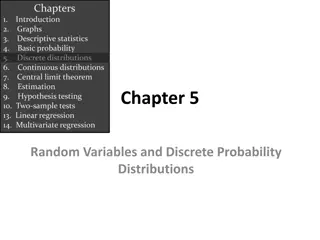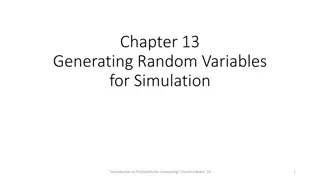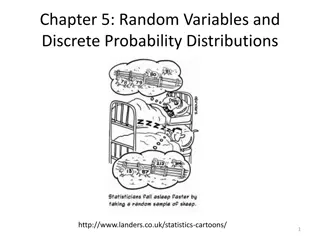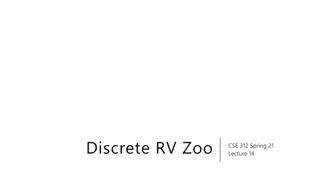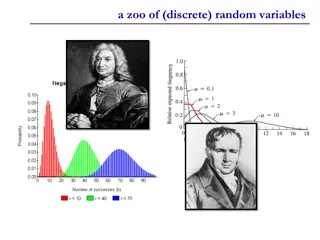Statistical Learning: Discrete Random Variables and Distributions
Explore the concepts related to discrete random variables and their corresponding probability density functions, such as Poisson Distribution and Binomial Distribution. Understand the implications of negative values in random variables, calculate expected values, and grasp the relationships between different sampling distributions. Dive into the world of statistical learning with this comprehensive tutorial.
Download Presentation

Please find below an Image/Link to download the presentation.
The content on the website is provided AS IS for your information and personal use only. It may not be sold, licensed, or shared on other websites without obtaining consent from the author.If you encounter any issues during the download, it is possible that the publisher has removed the file from their server.
You are allowed to download the files provided on this website for personal or commercial use, subject to the condition that they are used lawfully. All files are the property of their respective owners.
The content on the website is provided AS IS for your information and personal use only. It may not be sold, licensed, or shared on other websites without obtaining consent from the author.
E N D
Presentation Transcript
TUTORIAL-II Statistical Learning (Part-A) 1
OBJECTIVES 1. Which of the following mentioned standard Probability density functions is applicable to discrete Random Variables? a) Gaussian Distribution b) Poisson Distribution c) Gamma Distribution d) Exponential Distribution 2
OBJECTIVES 2. If the values taken by a random variable are negative, the negative values will have _______ a) Positive probability b) Negative probability c) May have negative or positive probabilities d) Insufficient data 3
OBJECTIVES 3. The expected value of a random variable is its ___________ a) Mean b) Standard Deviation c) Mean Deviation d) Variance 4
OBJECTIVES 5. For larger values of n , Binomial Distribution ___________ a) loses its discreteness b) tends to Poisson Distribution c) stays as it is d) gives oscillatory values 6
OBJECTIVES 6. The recurrence relation between P(x) and P(x +1) in a Poisson distribution is given by ___________ (a) (b) (c) (d) P(x+1) m P(x) = 0 m P(x+1) P(x) = 0 (x+1) P(x+1) m P(x) = 0 (x+1) P(x) x P(x+1) = 0 7
OBJECTIVES 7. In the following Table, Column A lists some sampling distributions, whereas Column B lists the name of sampling distributions. All symbols bear their usual meanings. Column A Column B (A) (W) Normal distribution (B) (X) Chi-squared distribution (C) (Y) t-distribution (D) (Z) F distribution Some matchings from Column A and Column B are given below. Select the correct matching? (A)-(Z), (B)-(X), (C)-(Y), (D)-(Z) (A)-(X), (B)-(Z), (C)-(W), (D)-(W) (A)-(Y), (B)-(W), (C)-(X), (D)-(Y) (A)-(W), (B)-(Y), (C)-(Z), (D)-(X) a) b) c) d) 8
OBJECTIVES 8. Which of the following statement sounds reasonable? a) If the sample size increases sampling distribution must approach normal distribution. a) If the sample size decreases then the sample distribution must approach normal distribution. a) If the sample size increases then the sampling distribution much approach an exponential distribution. a) If the sample size decreases then the sampling distribution much approach an exponential distribution. 9
OBJECTIVES 10
OBJECTIVES 11
NUMERICALS 1. A bitcoin if you toss it gives any value in the range [0 9] both inclusive. Assume that the random variable X represents the toss value of the bitcoin which has a discrete uniform distribution and is shown in the following figure. 12
NUMERICALS 2. A quiz test for a course Data Analytics was conducted for a total score of 100 where 600 students took the test. From the result of the test it was found that mean score = 90 and standard deviation = 20. Students are randomly distributed among six sections and each section includes 100 students. In one of the section of 100 students, the mean score is found as 86. a) b) What is the standard error rate? If you select any section at random, what is the probability of getting a mean score is 86 or lower? 13
NUMERICALS 3. On average, 3 traffic accidents per month occur at a certain intersection. What is the probability that in any given month at this intersection a) b) c) exactly 5 accidents will occur? fewer than 3 accidents will occur? at least 2 accidents will occur? 14
NUMERICALS 4. A large chain retailer purchases a certain kind of electronic device from a manufacturer. The manufacturer indicates that the defective rate of the device is 3%. a) The inspector randomly picks 20 items from a shipment. What is the probability that there will be at least one defective item among these 20? Suppose that the retailer receives 10 shipments in a month and the inspector randomly tests 20 devices per shipment. What is the probability that there will be exactly 3 shipments each containing at least one defective device among the 20 that are selected and tested from the shipment? b) 15
NUMERICALS 5. A soft-drink machine is regulated so that it discharges an average of 200 milliliters per cup. If the amount of drink is normally distributed with a standard deviation equal to 15 milliliters, a) what fraction of the cups will contain more than 224 milliliters? b) what is the probability that a cup contains between 191 and 209 milliliters? c) how many cups will probably overflow if 230- milliliter cups are used for the next 1000 drinks? d) below what value do we get the smallest 25% of the drinks? 16
